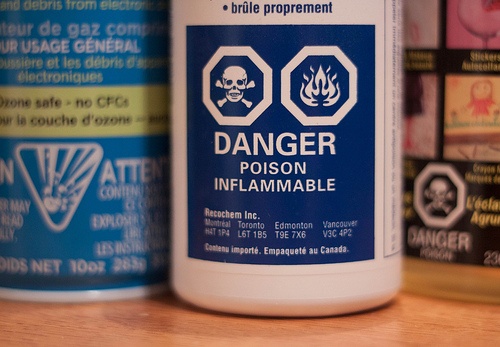OSHA issues safety standards for the design and use of portable powered tools and other handheld equipment items. (29 CFR 1910.242 – 1910.244). These standards focus on safe use of powered hand tools, as well as on safety features such as lock-outs and guards. The standards define general requirements for all equipment defined as powered hand tools, including specific definitions for following: explosive-actuated; fastening tools; abrasive wheels; and jacks. The remainder of this note summarizes these requirements.
Read MoreAudit, Compliance and Risk Blog
Tags: Health & Safety, OSHA, Safety and Health at Work, workplace safety
New York adopts workplace violence requirements for retailers
Posted by Jon Elliott on Thu, Sep 26, 2024
On September 5, New York’s governor Kathy Hochul signed the Retail Worker Safety Act (A8947-C/S8358-C) to require employers to take steps to protect employees in retail stores from workplace violence (NY Labor Law sec. 27-e). The new law assigns the New York Department of Labor (NYDOL) to develop model policy and training documents for use by employers. Most requirements are effective as of March 4, 2025. These retail workplace violence prevention (WVP) requirements are comparable to public sector employer requirements in place since 2007 (NY Labor Law sec. 27-b), which are also administered and enforced by NYDOL. The rest of this note describes these new requirements.
Read MoreTags: Health & Safety, Workplace violence, Safety and Health at Work, workplace safety, safety violations
While the world adapts to the ongoing presence of COVID-19 and its hazards, other potential pandemic diseases continue to cause concerns. One example is avian influenza, also known as bird flu. In the US, the Centers for Disease Control and Prevention (CDC) and Occupational Safety and Health Administration (OSHA) note that avian influenza H5N1 was first seen in the U.S. in migratory birds in 2015, and in agricultural poultry stock beginning in 2022. Since then, a few mammal infections have been confirmed, and in April 2024, a dairy farm worker tested positive for avian influenza A (H5N1). This history confirms a slow expansion of pathways to infection, and at-risk species extending to include humans. There have not yet been confirmed human-to-human transmissions, which could trigger the next pandemic if they began to proliferate (just as COVID-19 did a few years ago). As these concerns rise, in August 2024 OSHA gathered and updated safety information about Bird Flu, which I summarize below.
Read MoreTags: Health & Safety, OSHA, Safety and Health at Work, workplace safety
On August 30, the Occupational Safety and Health Administration (OSHA) published its proposal to adopt a new Heat Injury and Illness Prevention Standard (29 CFR 1910.148) covering most OSHA-regulated employers. This rulemaking expands OSHA’s ongoing efforts to protect workers against heat hazards; previously, the agency has emphasized that known heat hazards trigger the Employer’s General Duty Clause (I wrote about OSHA’s National Emphasis Program for both outdoor and indoor workplaces HERE ).
Read MoreTags: Health & Safety, OSHA, Safety and Health at Work, workplace safety, Heat, Be Heat Smart
California adds heat protection rules for indoor workplaces
Posted by Jon Elliott on Wed, Aug 07, 2024
This summer has again brought record-breaking heat to parts of North America. Outdoor work in the summer sun can lead to heat illness, as can indoor work in spaces that aren’t sufficiently insulated or cooled. Since 2005, California's Division of Occupational Safety and Health (Cal/OSHA) administers detailed regulatory requirements for outdoor workplaces; other jurisdictions have since adopted similar requirements (I wrote about these HERE). Indoor workplaces have been considered, too (the federal Occupational Safety and Health Administration (OSHA) initiated a National Emphasis Program for both outdoor and indoor workplaces in 2021, which I wrote about HERE). On July 23, 2024, California adopted new requirements governing indoor workplaces (8 California Code of Regulations (CCR) 3396), which I discuss in the rest of this note.
Read MoreTags: OSHA, Safety and Health at Work, workplace safety, Heat Wave, Heat, Be Heat Smart
OSHA requirements for employers’ emergency response activities
Posted by Jon Elliott on Wed, Jul 10, 2024
The Occupational Safety and Health Administration (OSHA) establishes Emergency Response planning, training, and procedure requirements for employers, as one self-contained part of its multi-pronged Hazardous Waste Operations and Emergency Response (HAZWOPER) Standard (29 CFR 1910.120). This note describes these requirements, and places them in the context of a variety of emergency response planning requirements.
Read MoreTags: Health & Safety, OSHA, Safety and Health at Work, workplace safety, Hazardous Waste
Since the 1980s, the Occupational Safety and Health Administration (OSHA) has required most employers to protect their workers from workplace chemical hazards, and to train workers to protect themselves. Most employers are subject to OSHA’s Hazard Communication Standard (HCS; 29 CFR 1910.1200), or to variants imposed by states delegated OSHA’s authority. Many of the present requirements were established by massive revisions adopted in March 2012, when OSHA recast HCS to align it with the United Nations-sponsored Globally Harmonized System of Classification and Labeling of Chemicals (GHS). OSHA’s 2012 revisions conformed the US to GHS Revision 3, which was issued internationally in 2002. The most obvious change was the adoption of Safety Data Sheets (SDSs) to replace longstanding Material Safety Data Sheets (MSDSs), but employers faced a series of deadlines during 2013-2016.
On May 20, 2024, OSHA significantly updated HCS requirements for the first time since 2012, primarily to reflect GHS changes through Revision 7 (which was published in 2017). OSHA’s revisions take effect on July 19. The remainder of this note summarizes these changes, based on the affected subsections or appendices.
Read More
Tags: OSHA, Safety and Health at Work, workplace safety, Hazardous Waste, Hazard Communication, Hazardous Chemicals
The Occupational Safety and Health Administration (OSHA) is authorized to inspect regulated workplaces, although it generally inspects only workplaces deemed highly hazardous (which typically are targeted sector-wide by OSHA National Emphasis Programs (NEPs) or their regional or state equivalents), or those subject response to complaints or reported incidents of injury or illness (I&I). On April 1, OSHA revised provisions in its inspection standard (29 CFR 1903) clarifying which “employee representatives” can accompany an inspector during a walk-around; the revisions are to become effective on May 31. This revision reflects part of broader inspection revisions proposed on August 30, 2023 (which I wrote about HERE). The rest of this note discusses the change to walk-around provisions.
Read MoreTags: Health & Safety, OSHA, Safety and Health at Work, workplace safety
This is the time of year when employers in many parts of the continent should be making focused effort to protect workers against winter weather. Occupational safety and health regulators include environmental and ambient hazards among those that employers must consider as part of their “general duty” to protect workers against recognized hazards. Requirements cover potential harm from extreme temperatures including cold, as well as slippery surfaces and other hazards from frozen and melting snow or other precipitation.
Agency regulations cover many specified types of situations, and guidelines are available for more. For example, the U.S. Occupational Safety and Health (OSHA) is drawing attention to its “Winter Weather” webpage as a source of information. The rest of this note summarizes information from OSHA’s webpage and those of other occupational safety agencies.
Read MoreTags: Health & Safety, OSHA, workplace safety, Winter, Weather
Saskatchewan extending workplace violence prevention requirements to all employers
Posted by Jon Elliott on Thu, Mar 07, 2024
Saskatchewan’s Employment Act (SEA) requires employers to take action to protect their employees against workplace violence. Since 1997, express requirements have applied to workplaces “prescribed” by regulations based on higher hazards; effective on May 17, 2024 these requirements apply in all workplaces, implementing SEA amendments enacted in 2023 by Bill 91 (“The Saskatchewan Employment (Part III) Amendment Act, 2022”). The rest of this summarizes workplace violence prevention (WVP) requirements set forth in the SEA, and in regulations issued and administered by the Occupational Health and Safety (OHS) Division of Saskatchewan’s Ministry of Labour Relations and Workplace Safety.
Read MoreTags: Health & Safety, Workplace violence, Safety and Health at Work, workplace safety, safety violations, OHS, SEA










